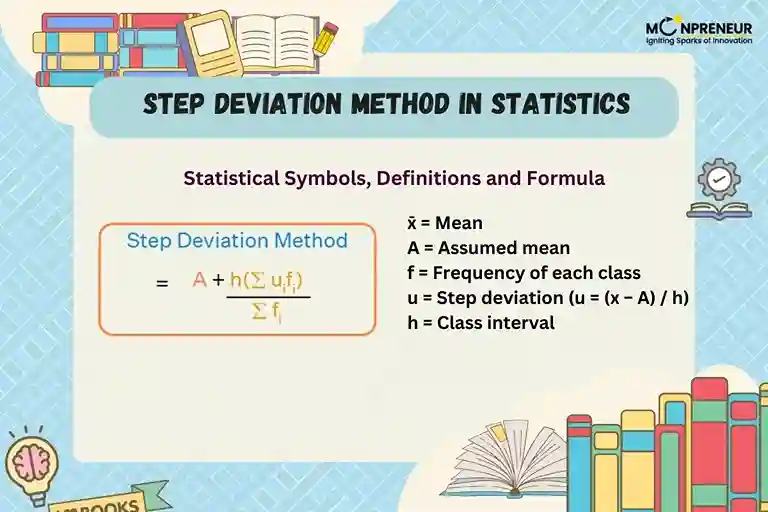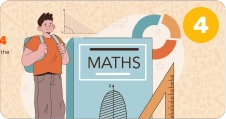The Step Deviation Method is a technique used in statistics to simplify the calculation of the mean for grouped data, particularly when dealing with large class intervals. It’s an extension of the assumed mean method, further simplifying calculations by reducing the deviations to smaller, more manageable values.

Key Concepts and Steps
- Class Marks (xᵢ): First, determine the midpoint of each class interval (xᵢ). This is done by adding the upper and lower limits of the interval and dividing by two.
- Assumed Mean (a): Choose an assumed mean (a) from the class marks. This is typically a value near the center of the distribution.
- Deviations (dᵢ): Calculate the deviation (dᵢ) of each class mark from the assumed mean: dᵢ = xᵢ – a.
- Step Deviations (uᵢ): Divide each deviation (dᵢ) by the class size (h) to obtain the step deviations (uᵢ): \(u_i = \frac{d_i}{h}\)
- Frequency Multiplication: Multiply each step deviation (uᵢ) by its corresponding frequency (fᵢ) to get fᵢuᵢ.
- Summation: Calculate the sum of fᵢuᵢ (∑fᵢuᵢ) and the sum of frequencies (∑fᵢ).
- Mean Calculation: Apply the formula:
\(\text{Mean} = a + h \times \frac{\sum f_i u_i}{\sum f_i}\)
When to Use the Step Deviation Method
The step deviation method is particularly useful when:
• The data is grouped into class intervals.
• The class intervals are uniform (have the same width).
• The values are large, making direct calculation of the mean cumbersome.
Formula of Step Deviation Method
Mean (x̄) = a + h × (∑fᵢuᵢ / ∑fᵢ)
Where:
a = Assumed mean
h = Class interval width
fᵢ = Frequency of each class
uᵢ = Step deviation = (xᵢ – a) / h
Step-by-Step Procedure
- Prepare the table with class intervals and frequencies.
- Find midpoints (xxx) of each class.
- Select an assumed mean (A).
- Calculate deviations: d=x−A
- Find step deviations: u=d/h
- Multiply f × u times for each class.
- Apply the formula to get the mean.
Example – How to Calculate Mean using Step Deviation Method
Imagine a dataset of student marks with class intervals like 10–20, 20–30, 30–40, and so on. If you have a large number of students, calculating the mean using the direct method could be tedious. The step deviation method simplifies this by reducing the deviations to smaller, more manageable numbers, making the calculation faster and easier.
Example of Step Deviation Method
| Class Interval | Frequency (f) |
|---|---|
| 0–10 | 5 |
| 10–20 | 8 |
| 20–30 | 10 |
| 30–40 | 7 |
| 40–50 | 5 |
Step 1: Class width (h) = 10
Step 2: Midpoints (xᵢ): 5, 15, 25, 35, 45
Step 3: Assume a = 25
Step 4: Deviations (dᵢ = xᵢ – a): -20, -10, 0, 10, 20
Step 5: Step deviations (uᵢ = dᵢ / h): -2, -1, 0, 1, 2
Step 6: fᵢuᵢ: -10, -8, 0, 7, 10
Step 7: ∑fᵢ = 35, ∑fᵢuᵢ = -1
Step 8: Mean = 25 + 10 × (-1 / 35) = 25 – 0.2857 ≈ 24.71
Applications of Step Deviation Method
• Used in educational statistics to calculate average marks in exams.
• Helpful in economic data analysis for simplifying large datasets.
• Common in industrial statistics for production and quality control.
Conclusion
The step deviation method is an efficient statistical technique for finding the mean of grouped data with large values and uniform intervals. By converting data into smaller step deviations, it reduces calculation complexity and saves time. This makes it a preferred method in academic, economic, and industrial data analysis.
Want to spark your child’s interest in math and boost their skills? Moonpreneur’s online math curriculum stands out because it engages kids with hands-on lessons, helps them apply math in real-life situations, and makes learning math exciting!
You can opt for our Advanced Math or Vedic Math+Mental Math courses. Our Math Quiz for grades 3rd, 4th, 5th, and 6th helps in further exciting and engaging in mathematics with hands-on lessons.
Related Blogs:
How to Teach Adjacent Angles to Kids | Simple & Fun Guide
What are Congruent Angles?
Understanding Alternate Interior Angles
What is the Area of Trapezoid?
What is the Area of Parallelogram?
Understanding the Geometry Regents: A Comprehensive Guide
How to Prepare for the Geometry Regents: Study Plans & Practice
The Art of Geometry: How to Draw an Equilateral Triangle Inside a Circle













